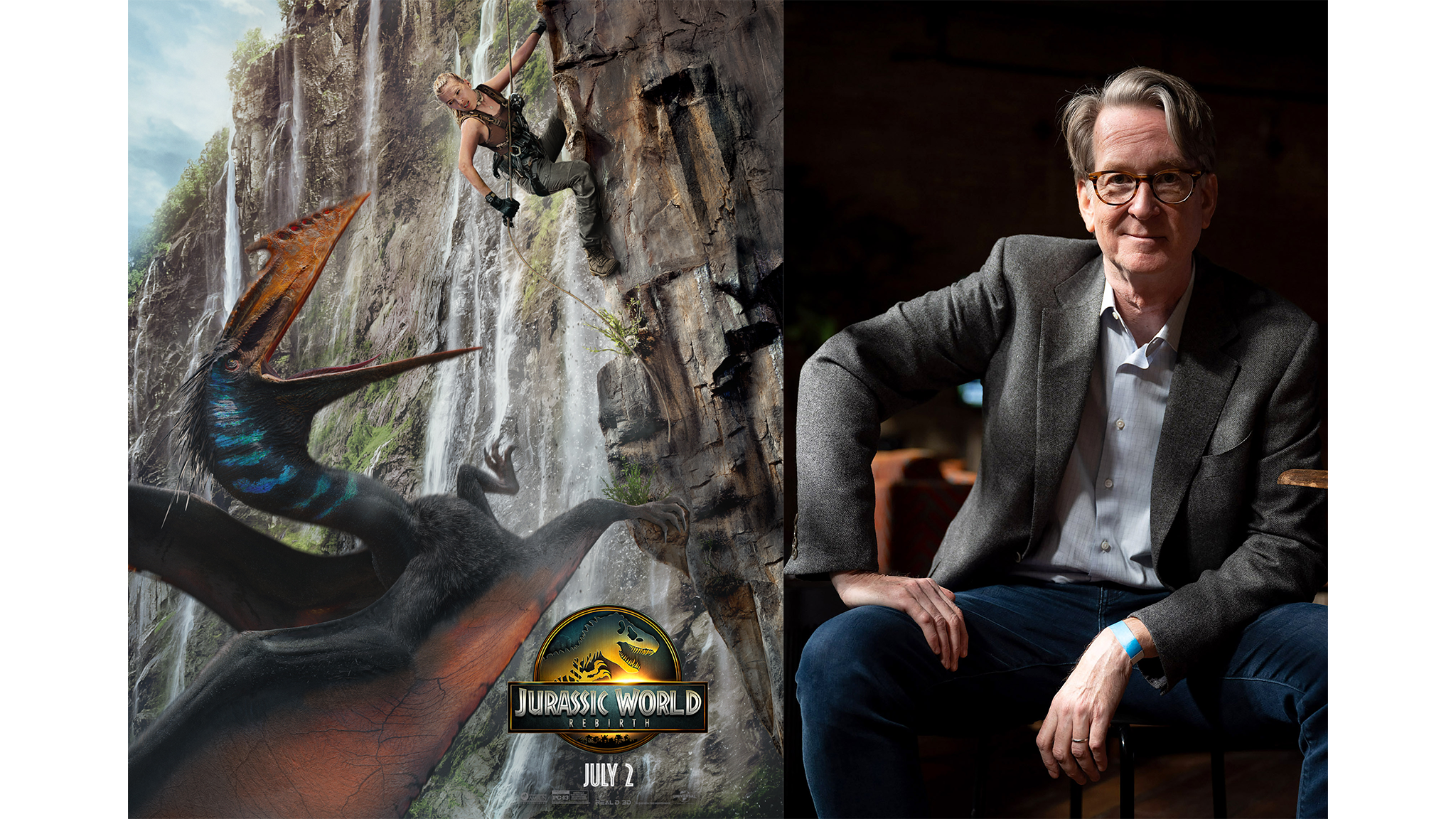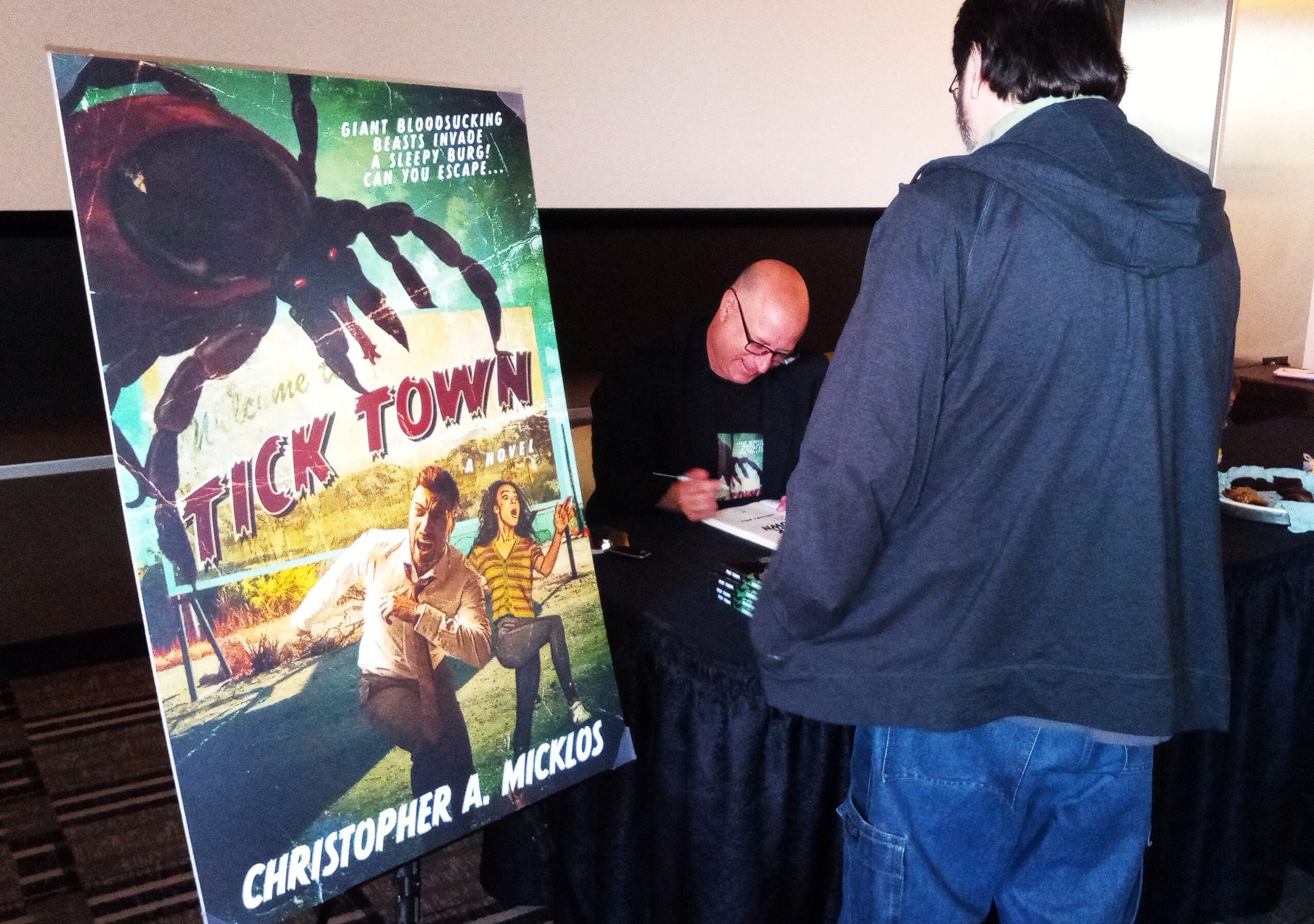We revisit some of our most blood-curdling and spine-chilling moments. Author Joe Hill talks about collaborating with his father, Stephen King. And filmmaker Don Coscarelli on his 1979 cult classic, “Phantasm.” Also, author Robin Means Coleman on the history of Black horror movies.
Featured in this Show
-
Writer Joe Hill On Storytelling, Film Adaptations Of His Work And Collaborating With Father Stephen King
Writer Joe Hill knows something about storytelling. In many ways, he received an up-close and personal view of it during his upbringing and that left a profound affect.
Today, Hill is the New York Times best-selling author of “The Fireman” and “NOS4A2” and the comic book series, “Locke and Key.” He also has the same knack as his famous father, novelist Stephen King, for having his works adapted for television or film. AMC has turned “NOS4A2” into a series and “Locke and Key” will be featured on Netflix.
Hill’s short-story collection, “Full Throttle,” is no exception. Two of the stories were co-written with King and one, “In the Tall Grass,” is already a Netflix horror movie.
The works of others have always been an important inspiration for Hill.
He said that one of his earliest movie memories is watching the 1971 made-for-TV movie, “Duel.” It’s about Charles Mann (played by Dennis Weaver) who is driving on a business trip. At a certain point, he encounters a Peterbilt 281 truck. The mysterious truck driver terrorizes Mann, repeatedly trying to destroy him and his car. The noted fantasy and science-fiction author Richard Matheson wrote the screenplay based on his short story of the same name. The film version was directed by a young Steven Spielberg.
“I loved it,” Hill told WPR’s “BETA.” “You know, it inserted itself into my fantasy life. My dad and I would go for drives and when we were out for drives, we’d pretend the truck was after us. We’d talk it through, you know, about what we’d do and where we’d go. And, you know, imagine the truck rearing up to slam the back end of our car. And I did a lot of screaming and stuff, you know, acting my part.”
The opening story in Hill’s new book is called “Throttle.” And it’s one of the stories he wrote with King.
“It is a kind of reinvention of Matheson’s ‘Duel,’” Hill said. “It’s a story about an outlaw motorcycle gang on the run from a faceless trucker who wants revenge on them for unknown reasons. And in some ways, it was like we started writing that story when I was 8 years old, you know. We started writing that story playing ‘truck’ in the car.”
Hill said he agrees with the idea that while in “Duel,” the audience never learns why the truck driver is trying to destroy Mann and his car. In “Throttle,” he and King have included some motivation for the truck driver’s homicidal tendencies.
“Yeah, ultimately, there is a revelation. There is a reveal. We find out why the trucker is after them. That sort of goes back a little bit to (legendary horror writer) H.P. Lovecraft. He had this idea that it was important to keep the horror offscreen. You know, that what we didn’t see was scarier than anything the artist could show. And I think there is some truth to that. I mean, like, certainly Spielberg in ‘Jaws.’ His happy discovery in the making of ‘Jaws’ was that the longer we went without seeing the shark, the more frightened of it we were.”
“But I do think — and this is something I sort of picked up from my dad — I do think at a certain point, it’s worth risking it,” he said. “That the reader does deserve some revelation, some understanding of what it was all about and that maybe the monster does have to come out from under the bed. You do have to shine a light into the back of the closet to see what’s hiding there.“
Hill explained what it was like to collaborate with his father, sometimes hailed as “king of horror.”
“You ever see any of those ‘Roadrunner’ cartoons? So, basically, imagine Wile E. Coyote getting a box that says ‘Acme’ on the side. And then he pulls apart the crate and inside, there’s a rocket. And he lights the fuse and climbs on top. And the rocket blasts off after the roadrunner. And Wile E. Coyote is hanging on top, barely clinging on for dear life. I’ve written with my dad on two short stories and both times, I felt like Wile E. Coyote hanging on to the rocket,” he said.
Since a book of short stories can’t have the same kind of flow as a novel, many might be curious as to how Hill decided the running order of the stories.
“I don’t how much strategy went into it, but you do look for some kind of coherent flow. You know, in a way, it’s sort of like trying to put together an LP. You want one song to flow naturally into the next. I know that the first story in the book is ‘Throttle’ and that the second story in the book is called ‘Dark Carousel.’ It’s set in the early 1990s. And it’s about four teenagers who deface a carousel, a big, 19th century carousel. And then there are supernatural consequences. ‘Dark Carousel’ is almost like a cover of a Stephen King story. It’s like the most Stephen King thing I’ve ever written.“
The second story that Hill co-wrote with King is called “In the Tall Grass.” This story might strike many readers as Lovecraftian cosmic horror crossed with a bit of a “Children of the Corn” vibe in terms of setting.
“I don’t know what we were going for exactly. We were both in Florida. He had just finished working on something and I had just finished working on something. And we went out to the Colonial House of Pancakes at like 10 p.m. in the evening. And we’re eating flapjacks or something and we both agreed we should write a story. And so we came up with something on the spot and wrote the whole thing in about six, seven days. You know, here we are a few years later and it’s going to be this big Netflix film. I think the drop date is Oct. 4. And it’s really scary, you know. I mean, what a great film. It was directed by Vincenzo Natali. This is horror for horror fans. It has a kind of relentlessly scary feel like ‘Hereditary’ or ‘It Follows.’ So it’ll be interesting to see what people make of it.”
Hill describes the story’s plot as one that should be chilling.
“‘In the Tall Grass’ is about a brother and sister, two people traveling across country from New England to California — Becky and Cal DeMuth. They’re somewhere in the heartland and they pull over at the side of the road because Becky isn’t feeling too well. She’s nine months pregnant. They get out and there’s this giant field at the side of the road. You know, the grass is like eight feet high. It’s up over their heads. And they hear a child screaming in the field. He’s screaming that he’s lost and he can’t find his way out. And so they both step into the grass to try to find him. And once they enter the field, they can’t find their way out either,” he said.
Hill said that while the movie draws from the short story, there are important differences.
“In some ways, the movie is actually a little bit more hopeful. It finds some hopeful notes that are unique to the film. And I think that that’s a good thing,” he said.
He added that he keeps his readers in mind when crafting his stories.
“Not every short story can deliver hope, though. I always feel like with a novel, you know, a novel takes anywhere between 12 and 24 hours to read a whole novel. And I kind of feel like anyone who slogs along that long, deserves something at the end, some kind of uplift, some reason to feel like the world is not all terrible,” he said. “I mean, they stuck with me that long, I want them to have something good at the ending. The short story works by different rules. That only takes one sitting to read. And a lot of the best short stories end with a final twist of the knife. And I do like that, I do like the ugly jolt of that final twist.”
-
David Lynch’s debut feature film, “Eraserhead,” is one of the most disturbing and frightening films of all time. Watching it feels like you’ve suddenly been parachuted into a black-and-white nightmare. Kristine McKenna is the co-author of David Lynch’s biographical memoir, “Room to Dream.” In this excerpt, she talks about the unnerving power of “Eraserhead.”
-
Filmmaker Don Coscarelli On His Indie Horror Hit, 'Phantasm'
Don Coscarelli is the youngest filmmaker ever to have a feature film distributed by a major studio. He was only 19 years old when he sold his independently-produced and critically-acclaimed drama, “Jim, the World’s Greatest,” to Universal Pictures.
But it was Coscarelli’s third film that put him on the map — an indie horror movie called “Phantasm.” He wrote it, photographed it, directed it and edited it.
“Phantasm” was released in 1979 and has since spawned four sequels. The film is now considered a cult classic and has appeared on many critics’ lists of best horror films. Coscarelli writes in great detail about making “Phantasm” and other films like “The Beastmaster” and “Bubba Ho-Tep” in his memoir, “True Indie: Life and Death in Filmmaking.”
“Somebody once told me that horror films make money,” Coscarelli told WPR’s “BETA.” “It’s funny because today that’s absolutely the truth because some of the most successful films are the horror and genre films. But at any rate, I got this bug in my mind that maybe my next film, I needed to do something a little bit more commercial. And so I decided to try doing horror.”
“Phantasm” is about a 12-year-old boy named Mike (played by Michael Baldwin), who lives with his older brother, Jody (played by Bill Thornbury). The two brothers are recent orphans. Mike is trying to come to grips with the loss of his parents and the potential loss of Jody who wants to leave.
“(Mike) has an active imagination but he just might be the sharpest knife in the drawer in that town,” Coscarelli said. “And he starts to notice some strange things going on. There’s a series of murders, one of their friends is killed. There’s a funeral up at this odd mortuary cemetery complex called Morningside. And our hero, Mike, witnesses some strange things and notices this strange, very enigmatic and sinister mortician (played by Angus Scrimm). And he and his brother and their neighborhood friend Reggie who’s the ice cream vendor (played by Reggie Bannister) get involved in trying to learn what is going on up here and pretty soon, it takes some really strange, frightening turns.”
Coscarelli explained that the inspiration for the story came from the way our society deals with death.
“There’s this strange practice of men dressed in dark suits and they’re in these mausoleums. And you give them the dead body of your deceased relative and it goes away into sort of a, I don’t know, experimentation or scientific operating lab. And then the corpse comes back looking kind of like your relative but not exactly … And I thought this would be a great setting for a horror film.”
Coscarelli was also inspired by a 1953 indie science-fiction movie called “Invaders from Mars.” The story revolves around a boy who witnesses a flying saucer disappear into the large sand pit behind his house. Nobody believes the boy when he tells them what he saw. Coscarelli was intrigued by the idea of having a kid who saw strange things but was left on his own to try to figure out what was going on.
“And not really knowing it, but I ended up making a mashup of horror, fantasy and science fiction,” Coscarelli said.
Coscarelli got the idea for the silver sphere that flies down the corridors of the Morningside funeral home from a dream he had when he was 15 years old.
“It’s maybe one of the only dreams I’ve remembered vividly enough to put into a film,” he recalled. While writing the film, Coscarelli decided the orb in his dream would make an interesting storytelling device.
“That image of the sphere and the way that this sphere, you know without giving away too much, it becomes a deadly killing device … the impact of that sequence really woke audiences up,” he said. “And a lot of people never forgot it. I will be introduced to people and they go ‘Oh, you did ‘Phantasm,’ … I don’t know if I know that movie.’ And then all I have to do is just put my hand with a couple of fingers out and go ‘You know, the one with the ball like that.’ And they immediately remember.”
The fact that the silver sphere was inspired by a dream is very appropriate because “Phantasm” plays out like one of the weirdest nightmares you’ve ever had. It’s surreal and dream-like. One could say it’s very similar to David Lynch’s first feature film, “Eraserhead,” in that way.
Coscarelli said when he made the film, he was willing to take risks in telling a “story in a different kind of style.”
“I was a little younger, a little more confident possibly like the young are … and as I was making the movie, I started to not worry so much about whether the audience was comprehending what I was doing exactly. And that’s a risky thing to do,” he said. “Thank God, it worked out. But I do think that by having it grounded with some real elemental scares throughout, it kept audiences’ attention.”
Forty years after its original release, “Phantasm” continues to have a devoted following. Coscarelli thinks there are a few reasons why the movie has struck a chord with so many people. One is the passion of horror fans and another is that the basic theme of what happens when you die is a universal question we all think about. Another is the strong family bond between the orphaned brothers.
Coscarelli says there’s one other element to “Phantasm’s” staying power that he’s discovered in recent years while meeting men in their 30s, 40s and 50s.
“They always tell me ‘You know, when I saw that movie, I just never forgot it because there was that kid and he was shooting a shotgun, he was driving his brother’s car, he was fighting the undead.’ In a weird way, and not by any design, I created this teen male empowerment movie.’”
-
The 'BETA' Team Shares Their First Horror Film Scares
After an interview with filmmaker Don Coscarelli about his groundbreaking horror film “Phantasm,” the “BETA” team sat down to discuss the first horror film that scared them to death. Here’s what they had to say:
J. Carlisle Larsen, ‘BETA’ Guest Host
“‘Close Encounters of a Third Kind’ really, really freaked me out. A little background: at the time I was watching it, I was probably around 6 or 7 getting a perm in my living room and I was trapped there, because my mom was doing the perm, watching the movie. Couldn’t escape. Had to watch all of it and it really freaked me out. So, it could’ve been the fumes or it could’ve been the movie, but it was definitely terrifying. Cannot watch it to this day,” Larsen said.
“I also lived in Nevada, which in the 90s, was the height of UFO stuff, so I was also very spooked,” she added.
Steve Gotcher, ‘BETA’ Technical Director:
“When I was a kid, around 10 years old, I lived in Los Angeles and there was this Saturday afternoon show that featured old horror movies and science fiction movies called ‘Strange Tales of Science Fiction.’ One afternoon they showed ‘Invasions of the Body Snatchers.’ It was the kind of film that made you feel very uncomfortable, the way it was shot, the way the dialogue went. The final scene in the film … I couldn’t sleep that whole night. It was terrible,” Gotcher said.
Doug Gordon, ‘BETA’ Host:
“I think I have to go with it because of the impact it had when I saw it was Alfred Hitchcock’s 1960 classic ‘Psycho.’ Well, for one thing, it’s one of the most iconic scores — the Bernard Herman score. Just all strings in the famous shower scene sting. Just the audacity Hitchcock had to kill off Janet Leigh’s character, Marianne Crane, at the end of the first act about 47 minutes into the film,” Gordon said.
Episode Credits
- Doug Gordon Host
- J. Carlisle Larsen Host
- Steve Gotcher Host
- Adam Friedrich Producer
- Steve Gotcher Producer
- Steve Gotcher Technical Director
- Kristine McKenna Guest
Wisconsin Public Radio, © Copyright 2025, Board of Regents of the University of Wisconsin System and Wisconsin Educational Communications Board.




